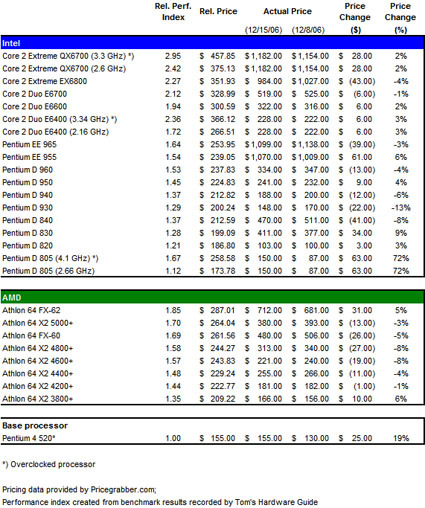As we approach the end of the Christmas shopping season, there is a certain kind of calmness in the microprocessor space: AMD rolled out the final products for this year, but they come too late to bring a visible impact to the pricing of most processors. Most of them are sitting in a comfortable space. Time to look at pricing histories to identify which CPUs are good deals around Christmas.
The idea for our processor price/performance charts was originally born from the necessity to analyze the dramatic price cuts we saw in dual-core desktop processor industry earlier this year. We discontinued the series in fall, but picked the topic back up when we noticed that many of our readers have a close idea on the microprocessor market and find current retail prices that is coupled with performance data a helpful tool to make their purchase decision.
We always welcome feedback to improve the usability our charts. One of those requests last week was to include a pricing history for each processor, which we thought was a fantastic idea to provide more transparency over the pricing trend of a particular processor you may be interested in. In the end, you really do not want to buy a CPU when its pricing peaks. We have included the pricing histories of AMD's and Intel processors that are included in our charts in this article. We will continue to do this from time to time.
We receive quite some feedback regarding the Core 2 Duo E6300 processor, which is still missing in our ranking. We know that it is the volume Core processor in the retail segment right now, but we have to ask you to remain patient. To be able to compare all processors side by side, we need to ensure a consistent benchmarking environment. As all data have been derived from Tom's Hardware's results, we also need to do this with the E6300. Tom's Hardware has not reviewed the E6300 yet. But we hear that there is a test of this CPU in progress and as soon as those data sets are available, the E6300 will be part of our ranking.
Let's have a look at this week's prices.

Click image to enlarge. Source: Pricegrabber.com
Amid these data, with about 90% of all processors' prices logging only single-digit percent changes, there is one that really sticks out, and it really caught us off guard. Intel's Pentium D 805, which had previously held one of the most constant price histories (between 10/6/06 and 12/8/06, prices were always between $87 and $102), skyrocketed this week, up 72% from last week's $87 to $150, a $63 and the most expensive price in our records. We were not able to confirm the exact reasons for this substantial increase, but keep in mind that this processor is being phased out and supplies will go down and dry up in more places. As the processor slowly disappears from retail shelves, the average price gets more volatile and you could see unusual peaks.
Stay On the Cutting Edge: Get the Tom's Hardware Newsletter
Get Tom's Hardware's best news and in-depth reviews, straight to your inbox.
It's also worth mentioning that, on the other side for Intel, the D 930 set a new record low after dropping $22/13% over last week's $170 average price. This is significant because this is one of only two of the processors we've been watching where, up until last week, we had never seen a price dip below our initial value from October 6.
We've been noticing constant price drops for AMD's processors ever since the announcement of the new quad-core and 65 nm processors. In fact, four of these eight processors in our data have shown continuous drops in price over the past three weeks, and even though none of them was significant in terms of dollar amount this week, we did log new record low prices for the FX-60 and 4200+.